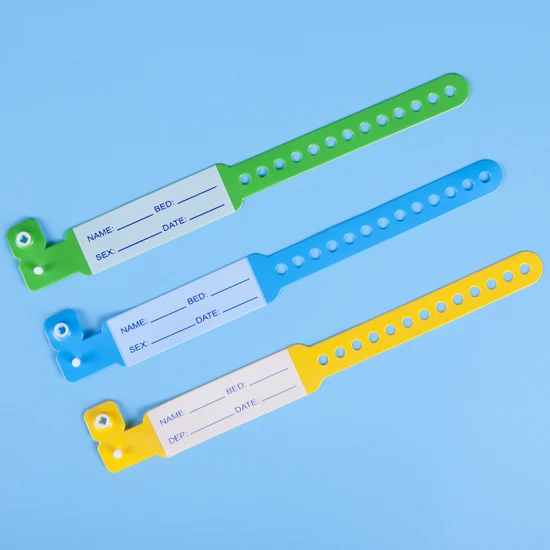The Link Between a Patient Identification Band and Enhanced Patient Confidentiality
The Link Between a Patient Identification Band and Enhanced Patient Confidentiality
Blog Article
Exploring the Numerous Sorts Of Patient Identification Band Utilized in Medical Facilities
In the elaborate world of medical care, the critical duty of Patient Identification bands usually goes undetected. These bands, varying from simple paper wristbands to advanced RFID bands, create the backbone of Patient security protocols, making certain accuracy in Patient Identification. The large variety of these bands, each with its special benefits and restrictions, is frequently forgotten. As we navigate via this topic, one might gain understanding right into the subtle intricacies and crucial relevance of such bands in medical centers.
Understanding the Significance of Patient Identification Bands
While they may seem like mere accessories, Patient Identification bands play a vital duty in clinical centers. These bands serve as a vital tool for validating Patient identification, stopping medical errors connected to misidentification. Patient Identification bands additionally help in enhancing administrative tasks, ensuring exact record-keeping and invoicing.
Standard Paper Wristbands: Their Usage and Limitations
Standard paper wristbands have been a staple in Patient Identification across numerous medical facilities. While their use prevails, they nurture particular restrictions that may influence their efficiency in Patient monitoring. This area will concentrate on the extent of their application and the intrinsic drawbacks connected with their use.
Paper Wristbands: Use Range
In the realm of Patient Identification, paper wristbands have long held a vital duty. These bands are usually utilized in outpatient setups, where the Patient's keep is temporary. Despite improvements in modern technology, the simple paper wristband stays a trusted and cost-effective option for Patient Identification in different medical care circumstances.
Limitations of Paper Wristbands
Despite their widespread usage, paper wristbands are not without their drawbacks. In enhancement, paper wristbands frequently do not have the technical abilities of even more contemporary alternatives, such as barcoding or RFID chips, restricting their functionality to just displaying created info. Paper wristbands can cause pain or skin irritation to some individuals, especially when used for extended periods.
Barcoded Wristbands: Innovations in Patient Identification
While Patient Identification has actually long been an essential aspect of healthcare, the advent of barcoded wristbands represents a considerable leap forward. These bands leverage the simplicity of barcoding technology, allowing for Patient details to be promptly checked and accessed. They improve the speed and accuracy of Patient Identification, minimizing the danger of medical errors connected to misidentification.
Superhigh Frequency Identification (RFID) Bands: an Action Towards Futuristic Health Care
The development of Patient Identification bands has brought regarding the development of Superhigh frequency Identification (RFID) Bands (patient identification band). These cutting-edge tools existing vital advantages for healthcare centers, using a much more efficient and technologically progressed ways of Patient Identification. The application of RFID in healthcare is a significant step towards an extra advanced technique to Patient monitoring and security
Comprehending RFID Bands

RFID Bands: Trick Benefits
Largely, these bands improve Patient security by giving precise, immediate Identification, thereby decreasing clinical mistakes. RFID bands i loved this can save a large amount of Patient information, including medical history and allergic reactions, enabling personalized care. In general, RFID bands represent a significant innovation in Patient Identification technology, benefiting both individuals and medical care suppliers.
Implementing RFID in Health Care
These bands provide a smooth means to track and recognize people, guaranteeing their safety and enhancing efficiency in therapy procedures. RFID bands minimize clinical mistakes by supplying precise Patient Identification, which is important in preventing misdiagnosis or incorrect medicine administration. Hence, the execution of RFID bands is a considerable action towards boosting Patient security and medical care shipment.

Color-Coded Wristbands: Helping in Quick and Accurate Medical Diagnosis
In the bustling setting of a medical facility, color-coded wristbands have see here now actually emerged as important tools for swift and specific Identification of an individual's medical condition. These wristbands, worn by clients, carry particular shades that correspond to different clinical problems or conditions. This system is created to use immediate visual hints to medical care companies, boosting Patient safety and care high quality.
Approaches for Reliable Implementation and Administration of Patient ID Bands
Attaining optimal use of Patient Identification bands requires a well-structured method for their execution and monitoring. The very first step involves training all health and wellness employees on the relevance of correctly applying and reading these bands. Healthcare facilities must systematize the use of ID bands across all departments, guaranteeing uniformity and reducing inconsistencies. Regular audits must be conducted to validate adherence to policies and to correct any disparities. Patient education and learning is likewise critical; people need to comprehend the function of the bands and the need for their consistent wear. patient identification band. Last but not least, it's important to have additional reading a back-up plan in place, such as barcode scanning or biometrics, to ensure that Patient Identification is never ever jeopardized.
Final thought
Patient Identification bands are vital in clinical facilities to make certain security and precision. Conventional paper, barcoded, RFID, and color-coded wristbands each hold one-of-a-kind advantages, varying from cost-effectiveness to advanced data storage space and immediate medical informs. Reliable application and monitoring of these bands can considerably minimize medical errors, improve efficiency, and enhance total Patient treatment. Thus, understanding and making use of these Identification tools is vital for keeping high standards in health care.
These bands, varying from simple paper wristbands to innovative RFID bands, form the backbone of Patient security procedures, making sure accuracy in Patient Identification.The advancement of Patient Identification bands has actually brought concerning the emergence of Radio Frequency Identification (RFID) Bands. Overall, RFID bands represent a significant development in Patient Identification technology, benefiting both clients and health care providers.
RFID bands minimize clinical errors by supplying precise Patient Identification, which is essential in avoiding misdiagnosis or incorrect medicine management. Patient education is also essential; patients must understand the objective of the bands and the demand for their continuous wear.
Report this page